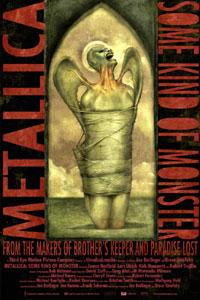Metallica: Some Kind of Monster (NR) ★★★½
 Heavy-metal band Metallica goes through two years of therapy to work through conflicts in their 20-year working relationship. This silly juxtaposition of hardened, tattooed headbangers lamenting about abandonment issues is precisely what makes this documentary both touching and entertaining.
Heavy-metal band Metallica goes through two years of therapy to work through conflicts in their 20-year working relationship. This silly juxtaposition of hardened, tattooed headbangers lamenting about abandonment issues is precisely what makes this documentary both touching and entertaining.
Story
After a particularly rough jamming session, Metallica frontman James Hetfield warns his bandmates that he's in a ''shitty mood,'' which basically means he's about to become one extremely uncooperative guy. Metallica, formed by Hetfield and drummer Lars Ulrich in 1981, have been through their share of problems in the past two decades, and it's not surprising to see them bickering like an old married couple. But as the film reveals, their issues are far more complex than some matrimonial spat, and the group is ready to shell out $40,00 a month to Phil Towle, a therapist and performance enhancement coach, to help them work through their differences and, hopefully, St. Anger--Metallica's first studio album in six years. Metallica: Some Kind of Monster documents this two-year struggle, which begins when Hetfield checks himself into rehab to sober up and leaves the band in limbo for almost a year. They eventually regroup, and after a few more clashes, record arguably their finest album since 1984's Ride the Lightening. This documentary covers everything about the band, including Ulrich's public bout with Napster that resulted in a fan backlash, the group's struggle to replace bassist Cliff Burton, who was killed in a 1986 bus crash in Copenhagen, and how to get rid of the increasingly controlling Towle once they've been ''cured.''
Acting
Hetfield and Ulrich share the spotlight in this documentary, which, ironically, is also the root of Metallica's problem--the constant tug of war between the two members for control of the group. Take Hetfield's post-rehab return to the studio: In order to keep his sobriety in check, the singer must stick to a regimented schedule, which includes limiting work hours from 12 p.m. to 4 p.m. daily. This irks Ulrich, who says Hetfield's demands are just a manipulative way of asserting his power over the group. But it's interesting to see how the presence of cameras, as well as Towle, affects the two's interaction. Rather than lash out at one another, they express their anger politely. ''I'm not enjoying being in the room with you playing,'' an annoyed Hetfield passively tells Ulrich after a hot disagreement over a tune. The underlying issue for Ulrich, however, becomes clear when he discusses former guitarist Dave Mustaine, who joined the band in '82 and was booted a year later. Ulrich laments that he and Hetfield use to be close, even declaring their love for one another after some 42 beers--until Mustaine came between them. Flying under the radar in this film is guitarist Kirk Hammett, who prides himself on being the ego-less member of the band.
Direction
Documakers Joe Berlinger and Bruce Sinofsky use their no-nonsense approach to filmmaking to deliver a straightforward documentary devoid of the usual narration and artistic cinematic effects and whittle away 715 days worth of footage into a 135-minute film. Although it's a bit on the long side, it works nonetheless thanks to the documentary's participants, who put themselves out there emotionally for the world to see. And while the filmmakers detail the inspiration behind various songs from St. Anger, the charm lies more in their personal trials and tribulations than their creative ones. But will Metallica's attempt to bare their souls win back the fans they lost because of Ulrich's attack on Napster? On May 3, 2000, Ulrich showed up at Napster's headquarters with the screen names of 350,000 users who had downloaded their songs and demanded each be removed from the online song-swapping aid. But in their fight to bring an end to Napster, Ulrich and the band alienated fans, who were quick to point out that Metallica benefited from the circulation of bootleg copies of their albums early in their career. Looking back, Ulrich comments the Napster thing made him ''the most hated f***ing ass in the history of rock 'n' roll,'' but doesn't elaborate beyond that. Berlinger and Sinofsky then show Ulrich making a cool $5 million off his oil-on-canvas paintings through Christie's, which makes the drummer's Napster fight look so damn petty. Even more interesting than the auction's bottom line is Ulrich's reasoning for selling the work that adorned the walls of his home for years: To wipe the slate clean.
Bottom Line
Joe Berlinger and Bruce Sinofsky may have set out to make a documentary about Metallica cutting a new album, but instead deliver a poignant portrait of rockers who aren't too macho to seek therapy if that's what it takes to salvage the band and their musical careers.
To get the full Quicklook Films experience, uncheck "Enable on this Site" from Adblock Plus
box office top 10

Challengers Released: April 26, 2024 Cast: Zendaya, Josh O'Connor 15M

Unsung Hero Released: April 26, 2024 Cast: Daisy Betts, Joel Smallbone 7.8M

Godzilla x Kong: The New Empire Released: March 29, 2024 Cast: Rebecca Hall, Brian Tyree Henry 7.2M

Civil War Released: April 12, 2024 Cast: Kirsten Dunst, Wagner Moura 7M

Abigail Released: April 19, 2024 Cast: Melissa Barrera, Dan Stevens 5.3M

The Ministry of Ungentlemanly Warfare Released: April 19, 2024 Cast: Henry Cavill, Eiza Gonzalez 3.9M

Kung Fu Panda 4 Released: March 8, 2024 Cast: Jack Black, Viola Davis 3.6M

Ghostbusters: Frozen Empire Released: March 22, 2024 Cast: Paul Rudd, Carrie Coon 3.3M

Dune: Part Two Released: March 1, 2024 Cast: Timothée Chalamet, Rebecca Ferguson 2M

Boy Kills World Released: April 26, 2024 Cast: Bill Skarsgård, Famke Janssen 1.7M






